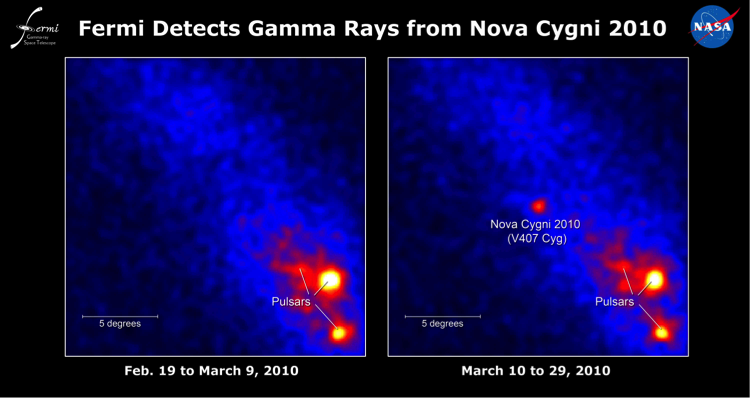Continuum emission from particle acceleration in novae
A galaxy such as our own naturally accelerates particles up to very high energies and at very high rates, compared to current human experiments. This flux of so-called cosmic rays permeates the interstellar medium and reaches any region of the galaxy. The processes by which this happens are only partially understood. The main source candidates are supernovae, through the shocks driven by their remnants in the environment, but several other powerful astrophysical objects probably contribute. These phenomena often have long evolutionary time scales, and observing them can only provide snapshots of the acceleration process, under different initial and boundary conditions. Getting a global understanding from that is thus a challenging exercise. Novae can be highly valuable here because they are to some extent nothing else than scaled-down supernova explosions, occurring much more frequently and having relatively short evolution time scales. At least five novae have been detected at GeV energies with the Fermi/LAT (V407 Cyg, Nova Sco 2012, Nova Mon 2012, Nova Del 2013, Nova Cen 2013), thus opening a new dimension for cosmic-ray studies.
 Fermi/LAT detection of the gamma-ray emission (> 100 MeV) of V407 Cyg in March 2010. Credit: NASA/DOE/Fermi LAT Collaboration |
Required instrument performances: The physical modeling of the data on V407 Cyg indicates that observations in the 1-100MeV can constrain the efficiency of particle acceleration at the shock, as well as the nature of the particle radiating gamma rays. Achieving that would require an extension of the GeV sensitivity of the Fermi/LAT instrument down to < 10 MeV.
| Performance parameter | Goal value | Remarks and notes |
|
Field-of-view (FWHM, deg) |
A few sr | Can be much less if instrument is to work from external triggers (optical or else…). |
|
Angular resolution (FWHM, deg) |
Not a concern, provided it does not complicate the extraction of the useful signal. | |
|
Spectral resolution (ΔE/E @ Energy) |
Not a concern, but required by nuclear gamma-ray lines studies of the same novae. | |
|
Line sensitivity (@ Energy) (cm-2 s-1, 3σ, 1 Ms) |
Not applicable. | |
|
Continuum sensitivity (in which energy band?) (cm-2 s-1 keV-1, ΔE=E, 3σ, 1 Ms) |
< 4×10-12 @ 100 MeV |
Goal is a flat sensitivity of < 6 × 10-11 erg/cm2/s over 1-100 MeV band, in order to discriminate inverse-Compton from pion decay spectrum. |
| Timing performances | Not applicable. | |
|
Polarimetric capability (Minimum Polarization Fraction for a Crab source in 1 Ms) |
|
Not applicable. |
| Real-time data? | Not applicable. |
 AstroMeV
AstroMeV